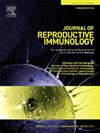在冷冻胚胎移植周期中,血液对移植导管和阴道微生物群对妊娠结局的影响和关联
IF 2.9
3区 医学
Q3 IMMUNOLOGY
引用次数: 0
摘要
冷冻胚胎移植(FET)周期中,导管上的血液和粘液对妊娠结局的影响仍未得到充分研究。为了评估移植导管上的血液和粘液以及阴道微生物群的特征对冷冻胚胎移植周期妊娠结局的影响,我们全面分析了 816 例患者的临床数据。我们仔细记录了胚胎移植(ET)后导管上可能存在的血液和粘液痕迹。我们检查了三个关键的结果参数,包括植入率(IR)、临床妊娠率(CPR)和生化妊娠率(BPR)。我们的结果表明,导管上的血液与 BPR 和 CPR 的明显下降有关,而粘液的存在对 BPR、CPR 和 IR 没有明显影响。为了进一步阐明导管带血对妊娠结局的影响是否由阴道微生物群失衡介导,我们使用 16S rRNA 基因测序法检测了阴道微生物群,并进行了深入的统计分析和相关性研究。有趣的是,血型组和非血型组之间阴道微生物群的α和β多样性存在显著差异。重要的是,血型阴道微生物群中乳酸杆菌的数量明显减少。我们的结果表明,导管上的血液对妊娠的负面影响可能是由于阴道微生物群的失衡造成的。这些结果为阴道微生物群与导管上的血液之间的关联及其对 FET 周期妊娠结果的影响提供了新的见解。本文章由计算机程序翻译,如有差异,请以英文原文为准。
The influence and association of blood on transfer catheter and vaginal microbiota on pregnancy outcomes in frozen-embryo transfer cycles
The effect of blood and mucus on the catheter on pregnancy outcomes in frozen-embryo transfer (FET) cycles remains relatively under-investigated. To evaluate the influence of the presence of blood and mucus on the transfer catheter, along with the characteristics of vaginal microbiota on pregnancy outcomes in FET cycles, we comprehensively analyzed the clinical data of 816 patients. We meticulously recorded the potential traces of blood and mucus on the catheter following embryo transfer (ET). We examined three key outcome parameters including implantation rate (IR), clinical pregnancy rate (CPR), and biochemical pregnancy rate (BPR). Our results demonstrated that the presence of blood on the catheter was associated with a marked decrease in BPR and CPR, whereas the presence of mucus had no significant impact on BPR, CPR, and IR. To further elucidate whether the influence of blood on the catheter on pregnancy outcomes was mediated by vaginal microbiota imbalance, we examined the vaginal microbiota using 16S rRNA gene sequencing and conducted in-depth statistical analyses and correlation studies. Interestingly, the alpha and beta diversity of the vaginal microbiota between the blood group and non-blood group differed significantly. Importantly, the abundance of Lactobacillus was markedly decreased in the blood group. Our results indicate that the negative effect of the blood on the catheter on pregnancy may be attributed to the imbalance of vaginal microbiota. These results provide new insights into the potential mechanisms underlying the association between vaginal microbiota and blood on the catheter and their impact on pregnancy outcomes in FET cycles.
求助全文
通过发布文献求助,成功后即可免费获取论文全文。
去求助
来源期刊
CiteScore
6.30
自引率
5.90%
发文量
162
审稿时长
10.6 weeks
期刊介绍:
Affiliated with the European Society of Reproductive Immunology and with the International Society for Immunology of Reproduction
The aim of the Journal of Reproductive Immunology is to provide the critical forum for the dissemination of results from high quality research in all aspects of experimental, animal and clinical reproductive immunobiology.
This encompasses normal and pathological processes of:
* Male and Female Reproductive Tracts
* Gametogenesis and Embryogenesis
* Implantation and Placental Development
* Gestation and Parturition
* Mammary Gland and Lactation.

 求助内容:
求助内容: 应助结果提醒方式:
应助结果提醒方式:


